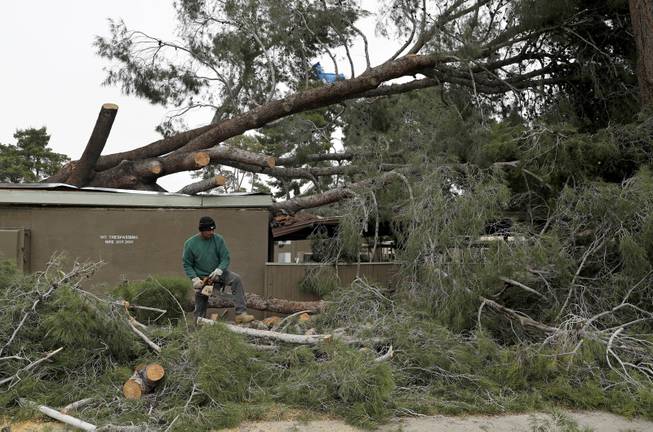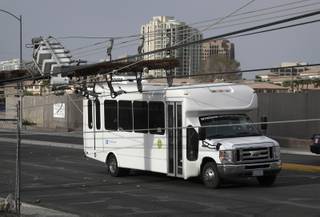
AP Photo/John Locher
A worker clears debris from a tree that fell on a structure, Friday, March 31, 2017, in Las Vegas. Workers are removing downed trees and restoring electricity in the Las Vegas area after a spring storm Thursday whipped winds to more than 70 mph (113 kph), overturning tractor-trailer trucks and dropping power lines onto cars near the Las Vegas Strip.
Tuesday, June 27, 2017 | 2 a.m.
Remember the mega-windstorm that damaged casino signs and held up air travel back in March? And another storm that interrupted power for thousands of Las Vegas residents just four days later?
Those two instances aren’t the only time winds of up to 40 mph have ripped through the Las Vegas Valley this spring. Yet despite what might seem like a chaotic few months for blustery weather here, wind speeds actually have gone down on average.
“We’ve seen a slight decline,” National Weather Service meteorologist Ashley Allen said. “A little bit below normal, but nothing out of the ordinary.”
Mean wind speeds in June are down 1 mile per hour from their 10.5 mph historic average, Allen said, while mean winds in May were down 2.5 mph from their historic average of 10.5 mph. April winds were down less than 1 mph from their historic averages and March winds were down 1.8 mph.
March through June is the Las Vegas Valley’s windiest period of the year, as the desert moves from its mildly chilly winter weather into its blistering hot summer months, Allen said. If the valley feels especially windy, that’s just because we are concluding the gustiest time of the year here. On average, this year is no windier than any other year.
“When people say ‘it was super windy this spring,’ they’re thinking about those one or two events,” Allen said. “In reality, it was quite mild otherwise.”
It’s different in other regions of the country such as the Midwest, where wind speeds reach their highs in September, October and November, and the Northeast, where they follow a similar pattern.
Wind in southern coastal states such as Florida are affected by the ocean, while others surrounded by land — such as Texas — mirror Southern Nevada’s wind pattern.
One of the main reasons for the winds here is the extreme variation in temperatures, Allen said. Average highs in the valley jump 40 degrees during the four-month period, from about 65 degrees Fahrenheit at the start of March to nearly 105 degrees by the end of June.
Lower pressure systems normally are synonymous with precipitation and cooler temperatures. When they make way for higher pressure systems, characterized by clear skies and heat, the atmosphere produces high winds as a way to “find its balance,” Allen said.
“The atmosphere just wants to be neutral,” Allen said. “You get big winds when there are big imbalances like that.”
Once summer temperatures settle in, the high pressure systems generally keep higher winds out of the valley.


Join the Discussion:
Check this out for a full explanation of our conversion to the LiveFyre commenting system and instructions on how to sign up for an account.
Full comments policy